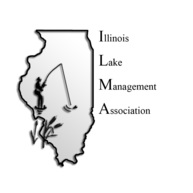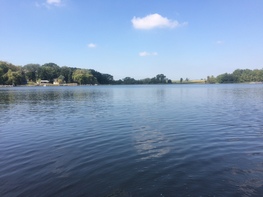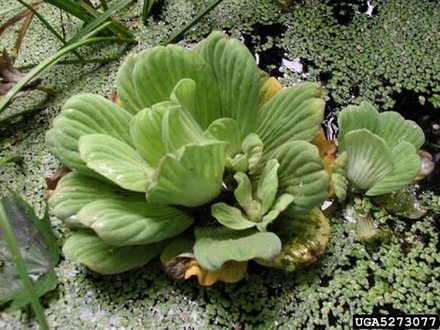 Water Lettuce (invasive species) released into a Creek in Lake County
A common and well-documented way that aquatic invasive species (AIS) can be introduced into new water bodies is through aquarium release, water garden escape, and live food and aquaculture release. Releasing aquatic plants and animals into natural habitats can be harmful to both the habitats and the organisms.
Although most organisms and plants are released into the wild with good intentions, these plants and animals usually cannot survive. Organisms that do survive can cause significant environmental and economic harm. These hardy non-natives plants thrive at the expense of native plants and animals. Ultimately, native species decline and the habitat changes, usually in an undesirable way.
In August 2013, IDNR added 27 aquatic plants to its injurious species list. The amendment makes it illegal to sell or transport the plants without permit. Included on the list are: Brazilian Elodea, anchored Water Hyacinth, Hydrilla, Eurasian Watermilfoil, Brittle Naiad, and Curlyleaf Pondweed to name a few. The rusty crayfish is listed for invertebrates. There are many ways to ensure that you do not release unwanted species into natural habitats.
Follow these useful tips to make better decisions on disposing unwanted plant materials.
- Create water gardens only in areas isolated from waterways to avoid accidental release.
- Inspect and rinse new aquatic plants to rid them of seeds, plant fragments, snails and fish.
- You can contact a retailer for proper handling advice or for possible returns.
- Give/trade with another aquarist, pond owner, or water gardener.
- Donate to a local aquarium society, school or aquatic business
- Seal aquatic plants in plastic bags and dispose in the trash.
- Contact a veterinarian or pet retailer for humane disposal guidance.
- Never include cuttings or unwanted plants in compost as seeds can be tolerant of drying and freezing.
 Road salt and other deicing materials are needed to keep Lake County’s roads, parking lots and sidewalks safe, but the products used can impact our water quality.
The Lake County Health Department, Stormwater Management Commission, Division of Transportation and the Public Works department offer deicing workshops to public agencies and private contractors to show how to wisely use road salt that will reduce the environmental impacts and help them save money.
Attendees can take an optional test at the deicing training workshop and join the rising ranks of plow drivers and salt applicators that are using best management practices to keep our roads safe—while reducing winter maintenance costs and pollution to our environment. You can help by asking your salt applicators if they are on the preferred winter maintenance providers list. If they are not on the list, encourage them to take our workshop to learn more about sensible salt practices.
Watch this video to learn more. You can access the 2017 preferred provider list here.
|
 The 33rd Annual Illinois Lakes Management Association Conference is taking place March 22-24 in Bloomington, Illinois at the BW Park Regency Hotel & Conference Center. This year's keynote speaker will be Molly Flanagan of the Alliance for the Great Lakes. Molly jointed the Alliance in April 2015 as Vice President for Policy and is responsible for leading aspects of strategic policy, advocacy, and reform efforts to protect and restore the Great Lakes.
With this keynote presentation and roughly 30 speakers, the conference will once again provide a full two days of technical presentations highlighting issues ranging from water quality to climate change to ways to improve your fishing habits. The third day of the conference will offer a chance to attend a workshop with Michael Bowers of the Audubon Society of Illinois to enhance your knowledge of waterfowl and shorebirds.
For more information and to register please visit www.ilma-lakes.org/conference. Registration is $130 for members and $150 for non-members (special discounts for HOA representatives and students are provided).
|
 Over the years the Cattail Chronicles has evolved from a print document to primarily electronic. This is the first look at our new Cattail Chronicles—which will be delivered electronically. Our goal is to have the Cattail Chronicles sent out quarterly, with shorter articles for each quarter rather than one long newsletter. Our hope is that we can provide you with more relevant information as it comes along and keep you informed of lake issues around the county.
If you have any topics you would like us to cover, please feel free to email Alana at abartolai2@lakecountyil.gov. All Cattail Chronicles will also be archived on our website and you can access them here.
|

Clues
- Non-native species
- Free-floating plant with spongy green leaves
- Leaves are 1-6" wide with large veins
- Very aggressive invader and can form thick mats
- If you see this around your lake, you should contact LCHD.
Think you know the answer? Email your best guess to ABartolai2@lakecountyil.gov.
Our Team
Mike Adam, Senior Biologist
Gerard Urbanozo, Water Quality Specialist
Alana Bartolai, Water Quality Specialist
|